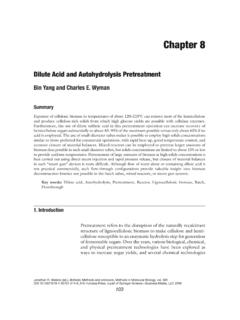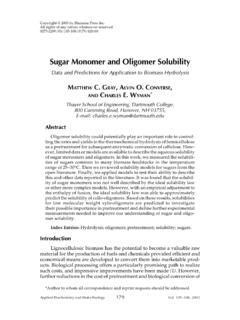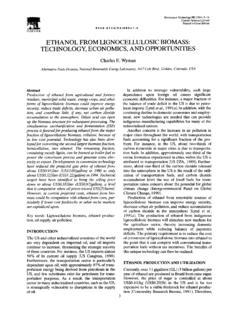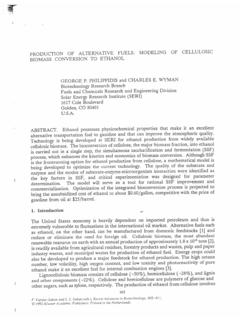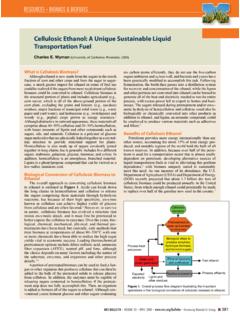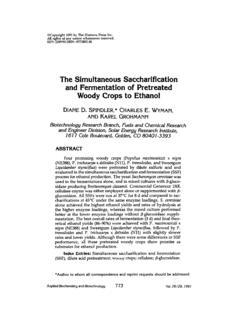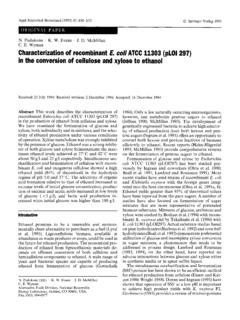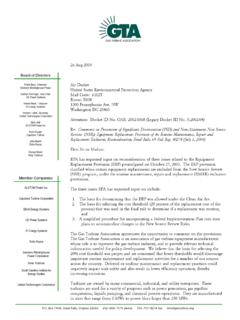Transcription of Review: Continuous hydrolysis and fermentation for ...
1 review : Continuous hydrolysis and fermentation for cellulosic ethanol productionSimone Brethauer, Charles E. Wyman*Center for Environmental Research and Technology and Chemical and Environmental Engineering Department, University of California, Riverside, CA 92507, United Statesarticle infoArticle history:Received 31 August 2009 Received in revised form 2 November 2009 Accepted 3 November 2009 Available online 14 December 2009 Keywords: Continuous fermentationEnzymatic hydrolysisFuel ethanolLignocellulosic biomassSimultaneous saccharification andfermentation (SSF)abstractEthanol made biologically from a variety of cellulosic biomass sources such as agricultural and forestryresidues, grasses, and fast growing wood is widely recognized as a unique sustainable liquid transporta-tion fuel with powerful economic, environmental, and strategic attributes, but production costs must becompetitive for these benefits to be realized.
2 Continuous hydrolysis and fermentation processes offerimportant potential advantages in reducing costs, but little has been done on Continuous processing ofcellulosic biomass to ethanol. As shown in this review , some Continuous fermentations are nowemployed for commercial ethanol production from cane sugar and corn to take advantage of higher vol-umetric productivity, reduced labor costs, and reduced vessel down time for cleaning and filling. On theother hand, these systems are more susceptible to microbial contamination and require more sophisti-cated operations. Despite the latter challenges, Continuous processes could be even more important toreducing the costs of overcoming the recalcitrance of cellulosic biomass, the primary obstacle to low costfuels, through improving the effectiveness of utilizing expensive enzymes.
3 In addition, Continuous pro-cessing could be very beneficial in adapting fermentative organisms to the wide range of inhibitors gen-erated during biomass pretreatment or its acid catalyzed hydrolysis . If sugar generation rates can beincreased, the high cell densities in a Continuous system could enable higher productivities and yieldsthan in batch fermentations. 2009 Elsevier Ltd. All rights IntroductionAccording to the recent report of the Intergovernmental Panelon Climate Change (IPCC) warming of the world s climate systemis unequivocal and is very likely due to the observed increases inanthropogenic greenhouse gas concentrations. Atmospheric con-centrations of carbon dioxide (CO2), the dominant greenhousegas, have increased from a pre-industrial value of about 280 ppmto 379 ppm in 2005, primarily as a result of fossil fuel use (IPCC,2007).
4 Overall, petroleum is the source of about 170 quadrillion(1015) BTUs or quads of energy of the total of more than 460 quadsthe world uses, far more than derived from coal, natural gas,hydroelectric power, nuclear energy, geothermal, or other half of petroleum in this total is used for transportation, anddemand is projected to grow rapidly as vehicle traffic increasesthroughout the world and even accelerates in Asia. Besides thenegative global warming impact of fossil fuels, volatile oil pricesand dependency on politically unstable oil exporting countries re-sulted in a significant increase in international interest in alterna-tive fuels and led policy makers in the EU and the US to issueambitious goals for substitution of alternative for conventionalfuels (Galbe and Zacchi, 2002; Wyman, 2007).
5 Ethanol made biologically by fermentation from a variety of bio-mass sources is widely recognized as a unique transportation fuelwith powerful economic, environmental and strategic generation ethanol made from starch-rich materials such ascorn and wheat or from sugar feedstock is a mature commodityproduct with a worldwide annual production of over 13 billion USgallons in 2007. However, these raw materials are insufficient tomeettheincreasingdemandforfuels,andcon cernshaveheightenedrecently that competition between the use of agricultural ,theuseof food crops for fuel production may lead to environmentally detri-mental indirect land use changes, the deforestation of ,thereductionofgreen-house gases resulting from use of starch-based ethanol is not as highas desirable (Farrell et al.)
6 , 2006; Hahn-H gerdal et al., 2006). Alter-natively, ethanol can be produced from lignocellulosic materialssuch as agricultural residues, wood, paper and yard waste in muni-cipal solid waste, and dedicated energy crops, which constitute themostabundantrenewableorganiccomponent inthebiosphere(Cla-assen et al., 1999).Regardless of the feedstock, the final ethanol selling prize mustbe competitive with that for gasoline, but gasoline benefits fromover a century of learning curve improvements and largely paidfor capital. Thus, profit margins in ethanol production processesare low, and returns on capital are uncertain due to the tremendous0960-8524/$ - see front matter 2009 Elsevier Ltd. All rights *Corresponding author. Tel.: +1 951 781 5703; fax: +1 951 781 Wyman).Bioresource Technology 101 (2010) 4862 4874 Contents lists available atScienceDirectBioresource Technologyjournal swings in petroleum prices.
7 In this context, costs must be keptas low as possible, and Continuous fermentation of cellulosic bio-mass to ethanol can offer important advantages in terms of greaterproductivity and lower costs. Unfortunately, although processdesigns have been conceptualized based on Continuous enzymatichydrolysis and fermentations to take advantage of their low costpotential, limited studies have actually been reported from whichto design or advance the technology. Thus, more information issorely needed on this subject to guide the advancement of lowercost approaches to making ethanol and overcome the significantcost barriers to market this paper, we will provide a short introduction to conceptsand characteristics of Continuous fermentations. Then a summaryis presented of experiences and research activities with first gener-ation industrial Continuous ethanol fermentations as these providethe foundation for second generation cellulose-based that, we review current knowledge of Continuous fer-mentation of lignocellulosic material, including those based onchemical and enzymatic hydrolysis of cellulose to Concept of Continuous fermentationsIn a true Continuous fermentation system, substrate is con-stantly fed to the reaction vessel, and a corresponding flow of fer-mented product broth is discharged to keep the reactor volumeconstant.
8 Furthermore, the balance between feed and dischargeis maintained for long enough times to achieve steady state oper-ation with no changes in the conditions within the reactor. Com-pared to a batch reaction, this mode of operation offers reducedvessel down time for cleaning and filling providing improved vol-umetric productivity that can translate into smaller reactor vol-umes and lower capital investments plus ease of control atsteady basic types of Continuous reactors can be employed: thecontinuous stirred tank reactor (CSTR) or the plug flow reactor(PFR). In an ideally mixed CSTR, the composition in the reactor ishomogenous and identical to that for the outgoing flow. In an idealPFR, the reactants are pumped through a pipe or tube with a uni-form velocity profile across the radius, and the reaction proceedsas the reagents travel through the PFR with diffusion assumed tobe negligible in the axial direction.
9 Consequently, PFR operationsimply that inoculum has to be constantly fed to the reactor for fer-mentation processes. Cascading a large number of CSTRs in serieswill have similar performance to a a system with constant overall reaction stoichiometry thatcan be described by a single kinetic equation, performing the reac-tion in two or more bioreactors may lead to a higher product con-centration, a higher degree of conversion, a higher volumetricproductivity, or a combination of these factors compared to opera-tion of a single CSTR. One approach to optimizing a Continuous pro-cess is to determine the reactor configuration that gives the lowestresidence time to achieve a certain degree of conversion. If thekinetics are known, a plot of the reciprocal rate against the dimen-sionless substrate concentrationS/Sfeedcan be employed to esti-mate the reaction residence time and therefore the reactionvolume (de Gooijer et al.)
10 , 1996). For a CSTR, the area correspondingto a rectangle whose height equals the reciprocal of the rate at thedesired conversion will equal the residence time for reaction tothis conversion, whereas the residence time for a PFR will corre-spond to the area under the curve (seeFig. 1). If the desired conver-sion is higher than the minimum in the curve, a combination ofreactors will require less reaction volume. Thus, for the situationdepicted inFig. 1, the combination of a CSTR followed by a PFR willbe preferred if a conversion of 98% is important performance criteria is the productivity of the fer-mentation system, , the amount of product formed per unit oftime and reactor volume, which depends on several factors includ-ing substrate concentration, cell concentration, and dilution used a simple model based on Monod growth kinetic that in-cludes terms for product and cell inhibition (Lee et al.
